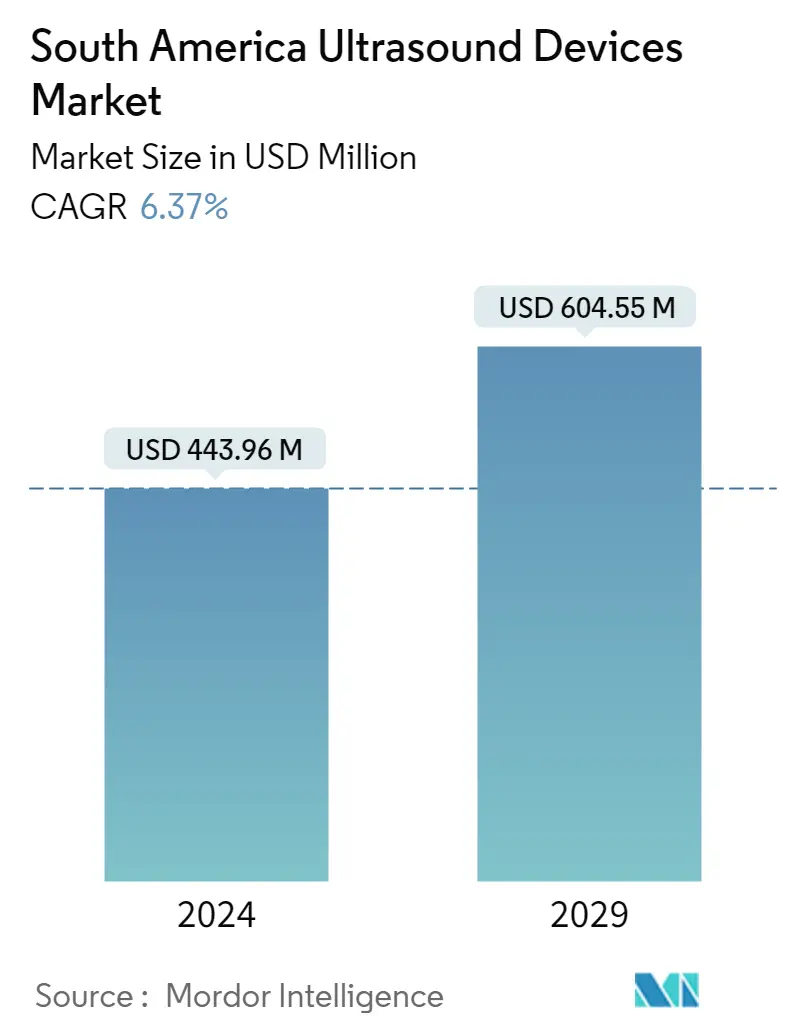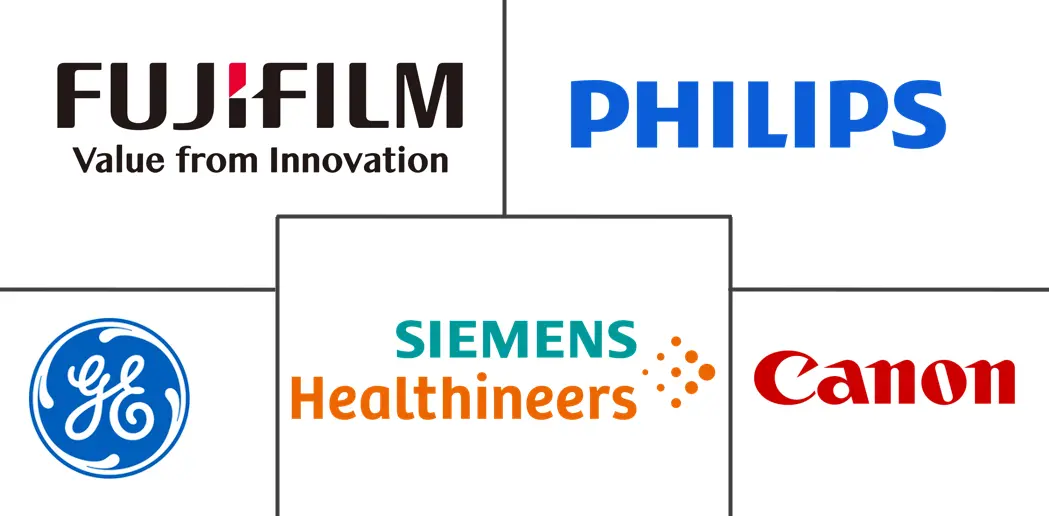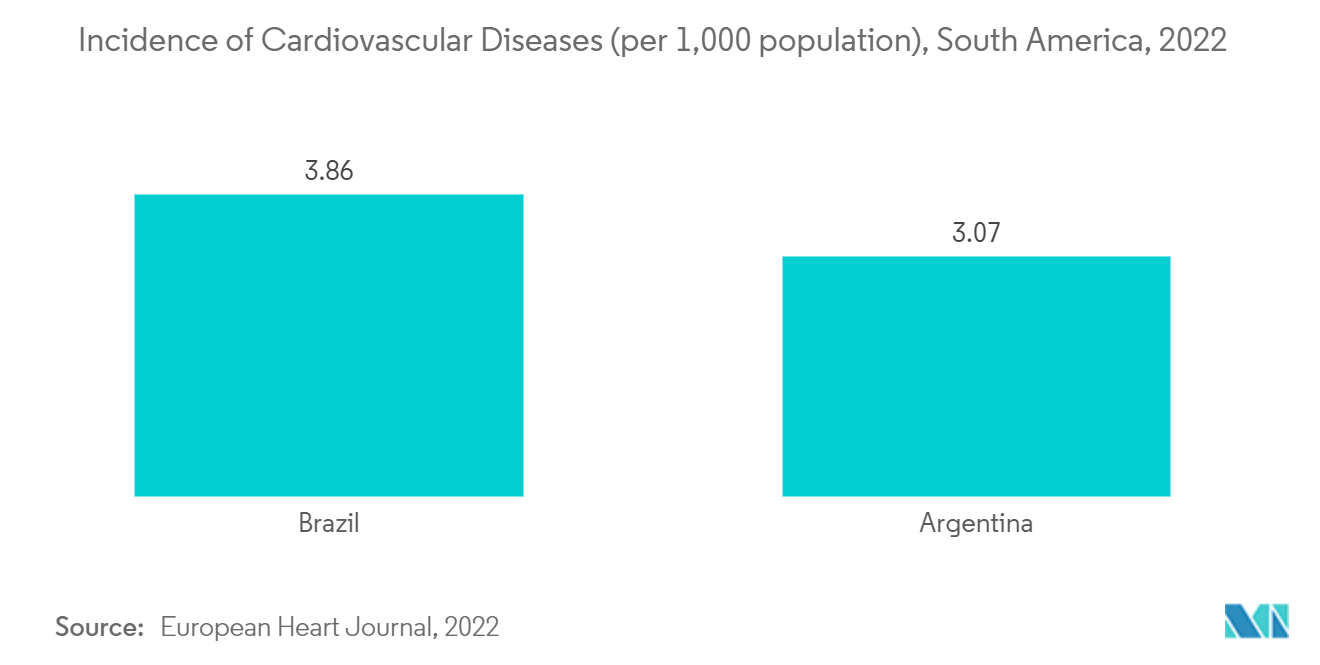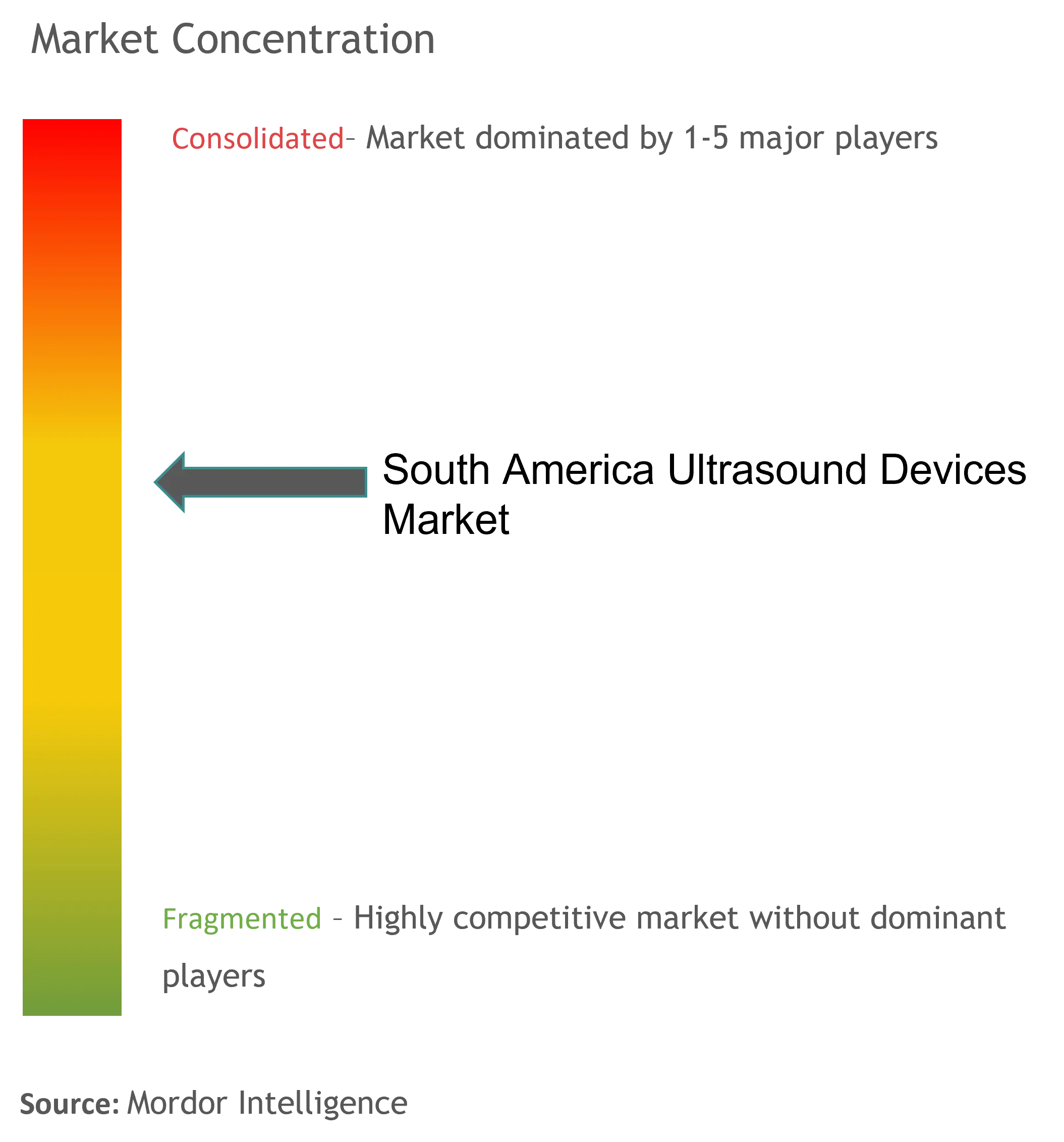South America Ultrasound Devices Market Size

| Study Period | 2021 - 2029 |
| Base Year For Estimation | 2023 |
| Forecast Data Period | 2024 - 2029 |
| Market Size (2024) | USD 443.96 Million |
| Market Size (2029) | USD 604.55 Million |
| CAGR (2024 - 2029) | 6.37 % |
Major Players
*Disclaimer: Major Players sorted in no particular order |
South America Ultrasound Devices Market Analysis
The South America Ultrasound Devices Market size is estimated at USD 443.96 million in 2024, and is expected to reach USD 604.55 million by 2029, growing at a CAGR of 6.37% during the forecast period (2024-2029).
During the initial phase of the COVID-19 pandemic, healthcare centers faced a considerable reduction in imaging procedures due to only-emergency surgeries or diagnoses being permitted in South America. However, Brazil's demand for ultrasound-guided minimally invasive tissue sampling (US-guided MITS) increased due to the suspension of complete diagnostic autopsies (CDAs). According to an article published in CID in December 2021, US-guided MITS procedures were conducted and shown to be safe and accurate. No staff members contracted COVID-19 infection during the procedures, and accuracy ranged from 69.1% for the kidneys, 90.1% for the lungs, and 98.7% and 97.5% for the liver and heart, respectively. Thus, South America's demand for technically advanced ultrasound procedures increased during the pandemic. Hence, owing to the aforementioned factor, the market is recovering from the damage caused by the pandemic. It is expected to have stable growth during the forecast period of the study.
Factors such as government and private funding for research and development (R&D) in ultrasound imaging, technological advancements, and the increasing incidences of chronic diseases in South America contribute to market growth over the forecast period.
Also, the burden of cancer has increased in South America. This is increasing the demand for ultrasound radiology imaging for cancer detection. As per an article published in CEBP in April 2022, when a study was conducted to provide statistics over time on cancer incidence, and mortality in the Barretos Region, Brazil, the age-standardized rates of incidence increased significantly for colon cancer, rectum, and rectosigmoid, liver, female breast, and thyroid cancer. As ultrasound is an ideal imaging modality for the detection and assessment of various cancers without exposure to any radiation, the demand for ultrasound devices is increasing. Thus, South America's increased cancer cases are anticipated to fuel market growth.
Therefore, the studied market is expected to grow significantly over the analysis period due to the factors mentioned above. However, the lack of skilled professionals to handle advanced equipment and strict regulations is expected to restrain the market growth.
South America Ultrasound Devices Market Trends
This section covers the major market trends shaping the South America Ultrasound Devices Market according to our research experts:
Cardiology Segment Anticipated to Witness Growth
To determine the presence of abnormalities in the heart's structure, measure the size and thickness of the heart and its chambers, and assess the motion of the chamber walls and the extent of damage to the heart muscle after a heart attack, physicians mainly advise an ultrasound. Cardiac ultrasound, also known as echocardiography, is a non-invasive diagnostic modality that provides detailed hemodynamic information quickly. Thus, with the high burden of cardiovascular diseases (CVDs) in South America, the demand for ultrasound is increasing, thereby fueling segment growth.
The high number of CVDs cases will lead to increased care for heart diseases, leading to increased adoption of MRI devices for diagnosing disorders. As per an article published in the European Heart Journal in August 2022, there was a more significant variation in mortality rates (per 1000 person per year) between countries in South America, with the highest in Argentina (5.98) and the lowest in Chile (4.07). In contrast, men had a higher incidence of CVD than women (4.48) vs. 2.60 per 1,000 population per year). This shows a high burden of CVD among the target population, which is further anticipated to drive the demand for echocardiography procedures, fueling the segment's growth in South America. Therefore, owing to the abovementioned factors, the segment is anticipated to witness growth over the forecast period.

Brazil Anticipated to Witness Significant Growth
Brazil is anticipated to grow significantly during the forecast period. The significant factors contributing to the market's growth include the rising prevalence of chronic diseases, the increasing number of screening programs, and the rising number of conferences and symposiums focusing on spreading awareness about the benefits of early screening and diagnosis.
According to the Globocan Mach 2021 update estimates, around 592,212 new cancer cases were reported in Brazil, and the five-year prevalence rate of cancers in Brazil was 1,563,761. Therefore, ultrasound diagnostic imaging devices are extensively used by doctors to examine and diagnose the exact medical conditions of patients. In addition, a few cancers or tumors are not visible in X-rays. Thus an ultrasound (also known as ultrasonography, sonography, or sonogram) helps doctors look for tumors in some regions of the body. With the high burden of cancer in South America, there is an increased demand for ultrasound devices, which is expected to boost the market's growth.
Additionally, technological advancements in ultrasound devices, the launch of new products by crucial regional companies, and the approval of new and improved technologies, along with the acquisition of advanced technologies for ultrasound devices by regional hospitals that are effective in the diagnosis and detection of various diseases will all contribute to the country's market growth. For instance, in September 2022, Brazil's Hospital das Clinicas (HC) in Sao Paulo deployed a private 5G network to test advanced connectivity in healthcare, which is planned to be applied to remote ultrasound exams. Hence, owing to the aforementioned factors, the market studied is expected to witness high growth over the forecast period in Brazil.

South America Ultrasound Devices Industry Overview
The South American ultrasound devices market is moderately competitive and consists of several major players. The threat of new entrants is moderate to high due to mid-size to smaller companies increasing their market presence by introducing new products at lower prices. Some of the market players in the studied market are Siemens Healthineers AG, Koninklijke Philips NV, GE Healthcare, Canon Medical Systems Corporation, and FUJIFILM Corporation, among others.
South America Ultrasound Devices Market Leaders
-
Canon Medical Systems Corporation
-
GE Healthcare
-
Hitachi Healthcare Systems
-
Koninklijke Philips NV
-
Siemens Healthineers
*Disclaimer: Major Players sorted in no particular order

South America Ultrasound Devices Market News
- July 2022: Maternova Inc. signed an agreement with BirthTech Lda to distribute its Preemie Test in multiple geographies worldwide. Maternova has an exclusive distribution agreement across Africa, Asia (except India), and Latin America (except Brazil) and non-exclusive rights in Brazil, India, the United States, and Europe.
- July 2021: To ensure the proper operation and production of Canon Medical System Brazil, Uniview products started monitoring the company's products to prevent any problems associated with imaging devices from Canon.
South America Ultrasound Devices Market Report - Table of Contents
1. INTRODUCTION
- 1.1 Study Assumptions & Market Definition
- 1.2 Scope Of The Study
2. RESEARCH METHODOLOGY
3. EXECUTIVE SUMMARY
4. MARKET DYNAMICS
- 4.1 Market Overview
-
4.2 Market Drivers
- 4.2.1 Government and Private Funding for R&D in Ultrasound Imaging
- 4.2.2 Technological Advancements
- 4.2.3 Increasing Incidences of Chronic Diseases
-
4.3 Market Restraints
- 4.3.1 Strict Regulations
- 4.3.2 Lack of Skilled Labor to Handle the Advanced Equipment
-
4.4 Industry Attractiveness - Porter's Five Forces Analysis
- 4.4.1 Threat of New Entrants
- 4.4.2 Bargaining Power of Buyers
- 4.4.3 Bargaining Power of Suppliers
- 4.4.4 Threat of Substitute Products
- 4.4.5 Intensity of Competitive Rivalry
5. MARKET SEGMENTATION (Market Size by Value - USD Million)
-
5.1 By Application
- 5.1.1 Anesthesiology
- 5.1.2 Cardiology
- 5.1.3 Gynecology/Obstetrics
- 5.1.4 Musculoskeletal
- 5.1.5 Radiology
- 5.1.6 Critical Care
- 5.1.7 Other Applications
-
5.2 By Technology
- 5.2.1 2D Ultrasound Imaging
- 5.2.2 3D and 4D Ultrasound Imaging
- 5.2.3 Doppler Imaging
- 5.2.4 High-intensity Focused Ultrasound
-
5.3 By Type
- 5.3.1 Stationary Ultrasound
- 5.3.2 Portable Ultrasound
-
5.4 By Geography
- 5.4.1 Brazil
- 5.4.2 Argentina
- 5.4.3 Rest of South America
6. COMPETITIVE LANDSCAPE
-
6.1 Company Profiles
- 6.1.1 Canon Medical Systems Corporation
- 6.1.2 Abbott Laboratories
- 6.1.3 GE Healthcare
- 6.1.4 FUJIFILM Corporation
- 6.1.5 Hologic, Inc.
- 6.1.6 Koninklijke Philips NV
- 6.1.7 Siemens Healthineers AG
- 6.1.8 Konica Minolta, Inc.
- 6.1.9 ESAOTE SPA
- 6.1.10 BOWA-electronic GmbH & Co. KG (BOWA Medical)
- *List Not Exhaustive
7. MARKET OPPORTUNITIES AND FUTURE TRENDS
** Subject To AvailablitySouth America Ultrasound Devices Industry Segmentation
Diagnostic ultrasound is an imaging technique that uses high-frequency sound waves to produce images of the different structures inside the body. These devices are utilized as both diagnostic imaging and therapeutic modality. They have a wide range of applications in the medical field.
The South America Ultrasound Devices Market is Segmented by Application (Anesthesiology, Cardiology, Gynecology/Obstetrics, Musculoskeletal, Radiology, Critical Care, and Other Applications), Technology (2D Ultrasound Imaging, 3D and 4D Ultrasound Imaging, Doppler Imaging, and High-intensity Focused Ultrasound), Type (Stationary Ultrasound and Portable Ultrasound), and Geography (Brazil, Argentina, and Rest of South America). The report offers the value (in USD million) for the above segments.
| By Application | Anesthesiology |
| Cardiology | |
| Gynecology/Obstetrics | |
| Musculoskeletal | |
| Radiology | |
| Critical Care | |
| Other Applications | |
| By Technology | 2D Ultrasound Imaging |
| 3D and 4D Ultrasound Imaging | |
| Doppler Imaging | |
| High-intensity Focused Ultrasound | |
| By Type | Stationary Ultrasound |
| Portable Ultrasound | |
| By Geography | Brazil |
| Argentina | |
| Rest of South America |
South America Ultrasound Devices Market Research FAQs
How big is the South America Ultrasound Devices Market?
The South America Ultrasound Devices Market size is expected to reach USD 443.96 million in 2024 and grow at a CAGR of 6.37% to reach USD 604.55 million by 2029.
What is the current South America Ultrasound Devices Market size?
In 2024, the South America Ultrasound Devices Market size is expected to reach USD 443.96 million.
Who are the key players in South America Ultrasound Devices Market?
Canon Medical Systems Corporation, GE Healthcare, Hitachi Healthcare Systems, Koninklijke Philips NV and Siemens Healthineers are the major companies operating in the South America Ultrasound Devices Market.
What years does this South America Ultrasound Devices Market cover, and what was the market size in 2023?
In 2023, the South America Ultrasound Devices Market size was estimated at USD 417.37 million. The report covers the South America Ultrasound Devices Market historical market size for years: 2021, 2022 and 2023. The report also forecasts the South America Ultrasound Devices Market size for years: 2024, 2025, 2026, 2027, 2028 and 2029.
South America Ultrasound Devices Industry Report
Statistics for the 2024 South America Ultrasound Devices market share, size and revenue growth rate, created by Mordor Intelligence™ Industry Reports. South America Ultrasound Devices analysis includes a market forecast outlook to 2029 and historical overview. Get a sample of this industry analysis as a free report PDF download.



